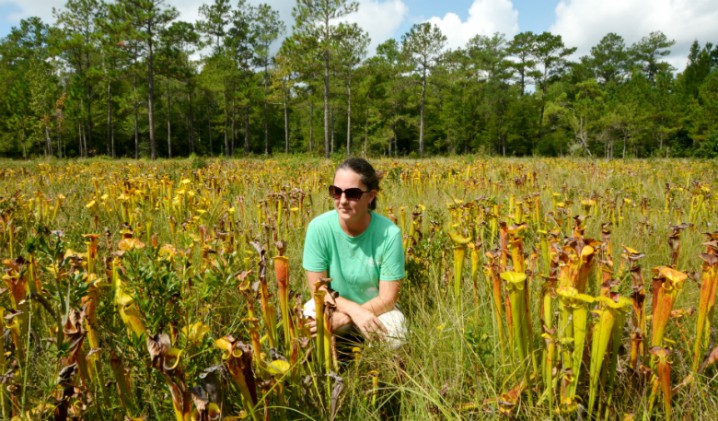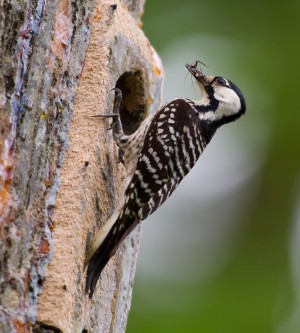First of two parts
When people ask her about the necessity of setting periodic forest fires, Angie Carl explains that coastal forests are really fire forests. “Just as a rain forest depends on rain, ours depends on fire,” she said.
As a fire specialist for The Nature Conservancy, Carl oversees what people in her business call “prescribed burns” – controlled fires that attempt to mimic the natural fires that once shaped the coastal landscape. So many of the rare plants we associate with our woodlands, from native grasses to orchids to Venus Flytraps, can’t exist without fire, she said. As so it goes with other members of the coastal ecosystem, from insects and birds to reptiles and mammals – each depending on the successive layers of forest growth and fire.
Supporter Spotlight
So close are the relationships between many species and fire, they likely developed over long periods of time. “These species evolved with fire,” said Kenneth Shughart, a Bladenboro-based forester with the N.C. Wildlife Resources Commission.
It’s no coincidence that our area has so many lightning strikes. “We have the second highest strike area, after Florida,” said Carl, a Wilmington resident who is the conservancy’s coastal fire and restoration manager. Historically, those strikes ignited fires that have burned through forests and grasslands, sometimes for months on end.
But as more and more people inhabited the coastal plain, fires were put out as quickly as possible to protect people and their homes and communities. “With prescribed burns, we are essentially just mimicking what nature would do,” Shughart said. “Before fire suppression was so intense.”
Proactive burn programs started in the 1950s and ’60s, according to the U.S. Forest Service. “This is especially true in the longleaf pine forests of the coastal plain,” said Patty Matteson, acting public affairs officer for the Forest Service. “More recently, we’re looking into what fire can do for the mountains and Appalachia.”
In the Southeast, talk of fire and longleaf pine often go hand-in-hand. At one point, it’s estimated that the tall pines covered 90 million acres from Virginia to Florida and west to Texas. Now, longleaf savannahs are only thought to cover about a quarter of that territory, according to The Longleaf Alliance, based in Alabama.
Although there are a number of factors for the decline, one often cited is the lack of fire in these forests. Without frequent burns, other pine species that are faster growing than the longleaf, such as loblolly and slash pine, shade out the young longleaf and soon dominate the forest plot. Once relegated to marginal areas, like the edges streams and ponds, these other forests are now more numerous.

In other fire-neglected areas, poor-quality hardwoods and shrubs have encroached, and there’s more competition for space, water and nutrients, which make it more difficult for native species to thrive. Fire, though, can limit this understory and give these endemic plants more room and resources.
Fortunately for the longleaf, a number of environmental organizations are working to re-establish this native ecosystem where possible through controlled burns. Each year, several thousand acres are burned in North Carolina, according to the Forest Service. Although other chemical and mechanical treatments have been tried, none is more effective than fire. Even one prescribed fire can improve habitat for wildlife, reduce the amount of debris that can cause accidental fires and increase access and travel for people and animals alike. Most forests and grasslands require multiple fires over a number of years to fully reach their potential, though, often on a schedule of every one to five years.
For many of the tiny, unique plants of the coastal plain, it’s sunlight that’s necessary for them to prosper and propagate. “A lack of fire means lack of sunlight,” Carl said. “And without sunlight, there are no orchids or pitcher plants.”

Plants are only the beginning of fire-dependent species, she said. “Not here, but elsewhere, there’s an insect that can only mate with the heat of the fire. Here, it’s a bit similar for red-cockaded woodpeckers.”
This endangered bird has very specific habitat requirements: mature pine forests with little understory, or the kind that depend on frequent fires.
Other species that are found in fire-prone areas include the indigo snake, the eastern coral snake and the gopher tortoise, which digs long burrows that help it and other species escape underground when fire comes to their forests.
There are also animals that require the habitat that results from one of the successive stages brought about by fire. The northern bobwhite benefits from frequent disturbance through prescribed fire. Grassland habitat is important for field sparrows and eastern meadowlark. The years between fires allow litter to accumulate for ground-nesting birds and offer scrubland birds like indigo bunting, blue grosbeak and brown thrashers a place to feed.
Some people fear how fire affects wildlife in the moment. But Carl said that often isn’t an issue. Burns are often conducted during non-critical, non-nesting times. “Many of these areas we’re talking about on the coastal plain also have wetlands and standing water,” she said.
Most animals escape the flames by going to the water or underground. Or they simply leave. “But they come back again,” she said.
Often the conditions are ideal for animals after a burn, for those who feed on insects, or those that forage for seeds from those plants that germinate during fire.
Wednesday: On a burn







